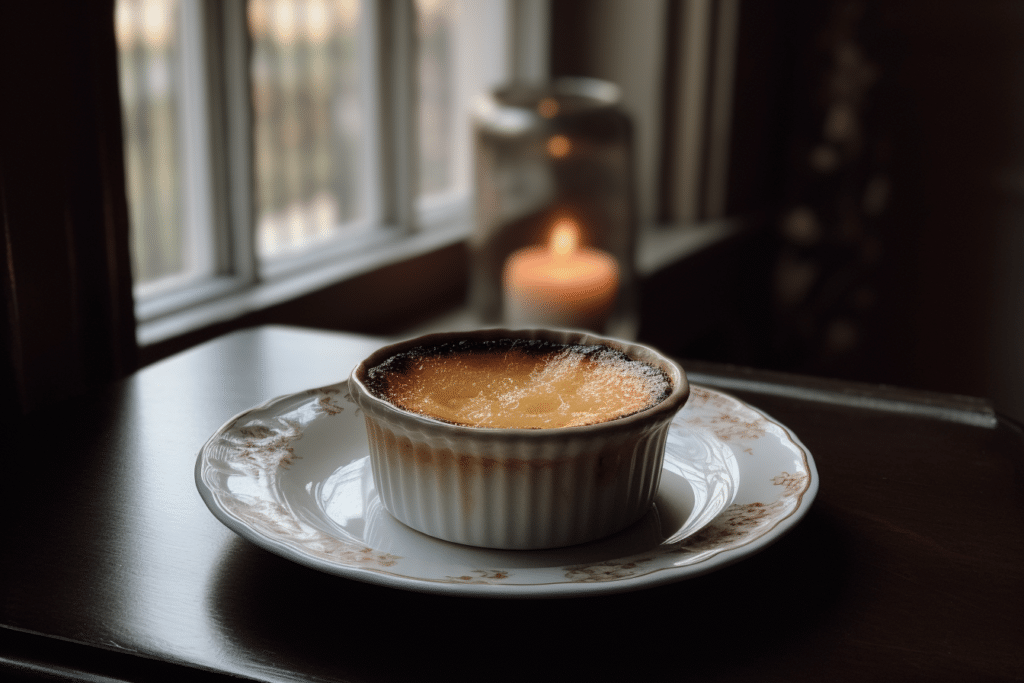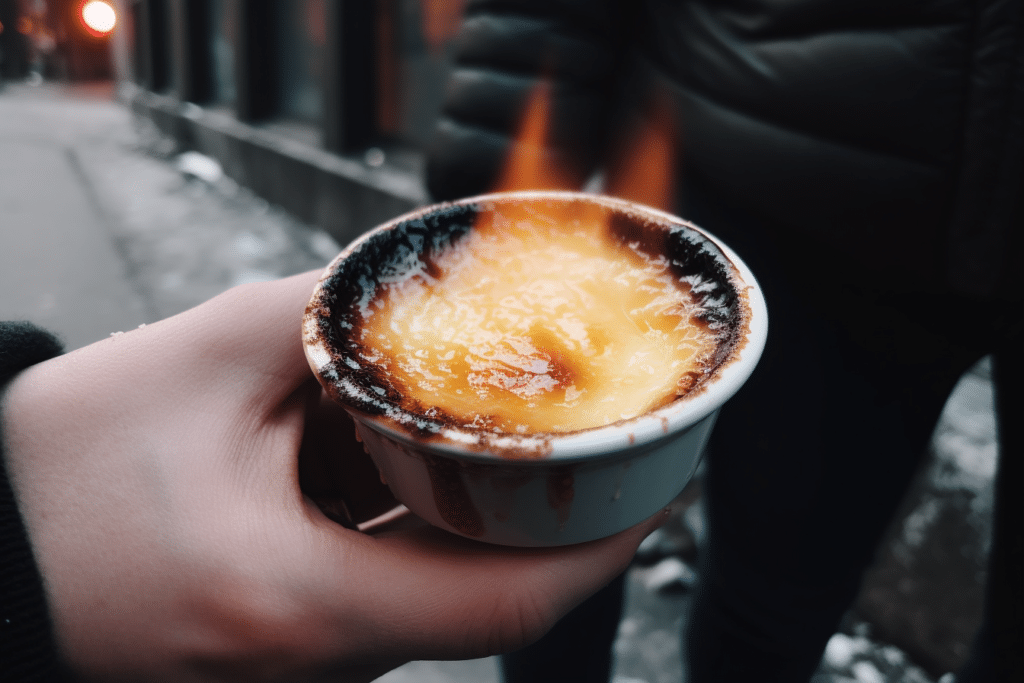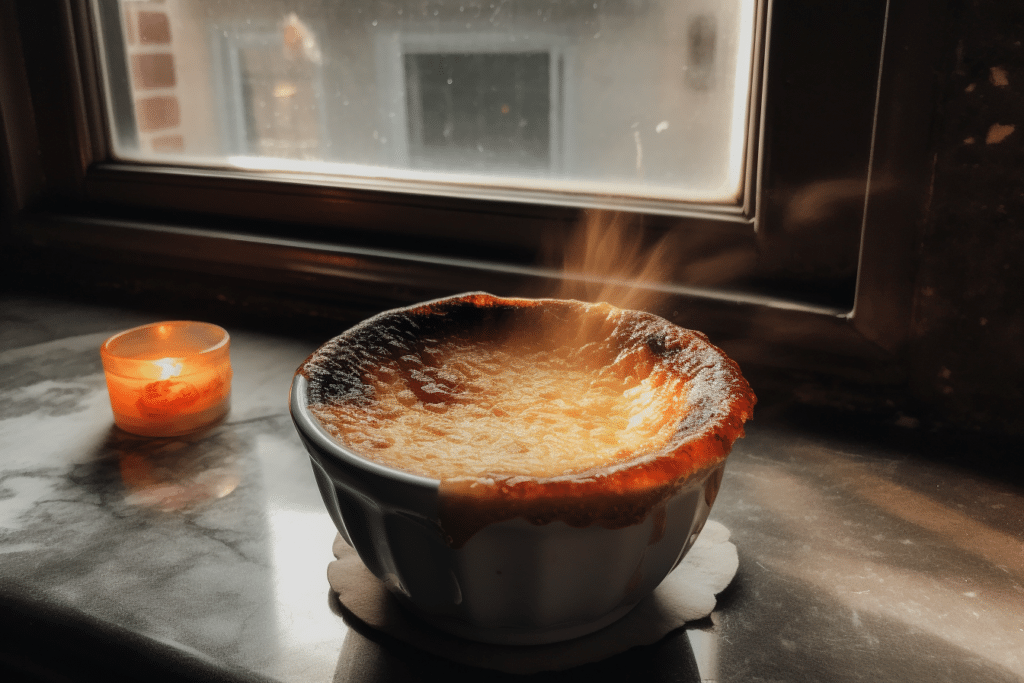1. Difference Between Crème Brûlée and Custard: What is Crème Brûlée?

Crème Brûlée, with origins tracing back to 17th-century France, has its earliest mentions in culinary literature. Often referred to as “burnt cream,” it is a rich and indulgent dessert that boasts a smooth custard base topped with a crisp caramelized sugar crust. While its creamy texture may resemble custard, understanding the difference between Crème Brûlée and custard highlights the unique techniques and features that set them apart. Originating in Europe, this elegant treat has become a hallmark of fine dining.
1.1 Difference Between Crème Brûlée and Custard: Definition
Crème Brûlée’s origins trace back to 17th-century France, with its earliest mentions in culinary literature. While the name is French, similar recipes have appeared in other European countries, such as Catalonia’s Crema Catalana.
The dessert features a custard base, typically flavored with vanilla. The real magic happens when sugar is sprinkled on top and caramelized, either with a torch or under a broiler, creating the distinctive hard crust.
1.2 Key Ingredients
The beauty of Crème Brûlée lies in its simplicity. The main ingredients include:
- Heavy cream, which provides richness.
- Egg yolks, essential for setting the custard.
- Granulated sugar for sweetness and the caramelized topping.
- Vanilla extract or beans for flavor.
Some recipes add twists like coffee, citrus, or spices, but the traditional recipe remains a classic.
1.3 Signature Features
Crème Brûlée stands out for its dual-texture contrast. The hard, glass-like caramel layer offers a satisfying crack, while the custard beneath is silky and creamy. This juxtaposition of textures defines its allure.
1.4 Popular Variations
While vanilla is the classic flavor, creative adaptations like savory options, such as Crab Brûlée, bring a unique twist to this traditional dessert, adventurous cooks have created countless variations:
- Chocolate Crème Brûlée for rich chocolate lovers.
- Citrus-infused Crème Brûlée featuring orange or lemon zest.
- Lavender or Matcha Crème Brûlée, appealing to modern tastes.
2. Difference Between Crème Brûlée and Custard: What is Custard?
Custard is a versatile dessert base with a rich history and countless culinary applications. It’s a simple mixture of eggs, sugar, and milk or cream, gently cooked until it thickens to a silky consistency.
2.1 Definition
Custard is a broad term that encompasses various dishes, including pastry cream, crème anglaise, and baked custards. While its origins are debated, custard has been a staple in many cuisines for centuries, especially in Europe and Asia.
Unlike Crème Brûlée, custard can serve as a dessert on its own or as a key component in dishes like pies, trifles, or tarts.
2.2 Key Ingredients
The essential elements of custard include:
- Milk or cream: The primary liquid that forms its base.
- Eggs: Provide structure through coagulation.
- Sugar: Adds sweetness and balances flavors.
- Optional ingredients include flavorings like vanilla, nutmeg, or citrus zest.
The ratio of these ingredients often determines the final texture, from pourable to sliceable.
2.3 Versatility
One of custard’s greatest strengths is its adaptability. It can be prepared in several forms, such as:
- Baked Custard: Firm and sliceable, used in dishes like flan.
- Stirred Custard: A creamy, pourable sauce, perfect for drizzling over desserts.
- Steamed Custard: Popular in Asian cuisines, offering a smooth, delicate texture.
This flexibility makes custard a favorite among both home cooks and professional chefs.
2.4 Variations and Types
Custard comes in many variations tailored to specific recipes:
- Pastry Cream: Thickened with starch, ideal for filling éclairs and cream puffs.
- Crème Anglaise: A thinner, pourable custard sauce often used with fruit or cakes.
- Flan or Caramel Custard: A baked custard with a caramelized sugar topping.
These variations demonstrate custard’s pivotal role in the culinary world.
3. Key Differences Between Crème Brûlée and Custard
Although Crème Brûlée and custard share a common foundation, they differ significantly in texture, preparation, presentation, and flavor. Understanding these distinctions can help you choose the perfect dessert for any occasion.
3.1 Textural Differences

The texture of Crème Brûlée sets it apart from custard. Its hard caramelized topping contrasts with the smooth custard beneath, creating a dual sensory experience. Custard, on the other hand, varies widely:
- Baked custard is firmer and more structured.
- Stirred custard is velvety and pourable.
This difference often comes down to the proportion of eggs and cream used in the recipe.
3.2 Cooking Methods
Crème Brûlée and custard are prepared using distinct techniques:
- Crème Brûlée: Always baked in a water bath to ensure even cooking. Once set, the top is caramelized using a culinary torch or broiler.
- Custard: Can be baked, stirred on the stovetop, or steamed, depending on the desired consistency.
The water bath in Crème Brûlée helps to achieve its iconic creaminess without curdling.
3.3 Presentation and Serving
Presentation plays a significant role in differentiating these desserts:
- Crème Brûlée is served in shallow ramekins to maximize the caramelized surface area.
- Custard is versatile, appearing in individual servings, as a pie filling, or as a sauce.
The caramelized topping in Crème Brûlée not only enhances flavor but also elevates its visual appeal.
3.4 Flavor Profiles
The rich, indulgent taste of Crème Brûlée comes from its heavy cream base, giving it a luxurious mouthfeel. Custard, depending on the recipe, can be:
- Mild and light, especially when made with milk.
- Rich and creamy, when heavy cream is used.
Flavor-wise, custard is often more adaptable, easily accommodating diverse additions like spices, fruits, or chocolate.
3.5 Cultural Context
Both desserts have unique cultural significance:
- Crème Brûlée is synonymous with French haute cuisine, often associated with special occasions.
- Custard enjoys broader applications and is embedded in the culinary traditions of many countries, from British trifles to Asian steamed custards.
This global versatility makes custard a more approachable option for everyday use.
4. Difference Between Crème Brûlée and Custard: Shared Characteristics of Crème Brûlée and Custard
While Crème Brûlée and custard have notable differences, they also share several similarities. These commonalities stem from their shared foundation of eggs, dairy, and sugar, making both desserts luxurious and comforting in their own ways.
4.1 Common Ingredients
Both desserts rely on a simple yet effective combination of:
- Eggs: Essential for creating the structure through coagulation.
- Dairy: Provides creaminess and richness.
- Sugar: Adds sweetness and enhances the overall flavor profile.
The versatility of these ingredients allows for easy customization, whether for dietary needs or flavor preferences.
4.2 Similar Techniques
The preparation of Crème Brûlée and custard involves similar cooking principles:
- Gentle Heat: Both require controlled cooking to avoid curdling or overcooking the eggs.
- Water Bath: Often used to regulate the cooking temperature and ensure a smooth texture.
These shared techniques emphasize the importance of precision and patience when working with custard-based desserts.
4.3 Base for Desserts
Both desserts serve as a foundation for countless culinary creations:
- Crème Brûlée is often adapted into flavored variations like chocolate or fruit-infused versions.
- Custard is the cornerstone for numerous dishes, including pies, trifles, and éclairs.
Their adaptability highlights their enduring popularity in the culinary world.
5. Difference Between Crème Brûlée and Custard: How to Choose Between Crème Brûlée and Custard
Deciding between Crème Brûlée and custard depends on several factors, including the occasion, dietary considerations, and personal preferences. Both desserts have their strengths, making the choice an exciting culinary decision.
5.1 Suitability for Occasions
- Crème Brûlée: Its sophisticated presentation makes it ideal for special occasions, romantic dinners, or upscale events. The caramelized topping offers a “wow” factor that delights guests.
- Custard: Its versatility makes it perfect for everyday enjoyment, family meals, or as a component in larger desserts like trifles and pies.
For formal dining, Crème Brûlée stands out, while custard excels in versatility.
5.2 Dietary Considerations
The richness of Crème Brûlée comes from its heavy cream base, which increases its calorie count. In contrast, custard can be made with milk, making it:
- Lower in fat.
- More suitable for those seeking a lighter dessert option.
Additionally, custard recipes can be adjusted for dietary restrictions, such as using non-dairy milk alternatives or reducing sugar content.
5.3 Ease of Preparation
Crème Brûlée requires a bit more technique, such as:
- Using a water bath for even cooking.
- Caramelizing the sugar topping with a torch or broiler.
Custard, by contrast, is more forgiving and easier for beginners to master. Stirred custards, for example, require less specialized equipment and can be made in one pot.
6. Difference Between Crème Brûlée and Custard: Tips for Perfect Crème Brûlée and Custard
Creating the perfect Crème Brûlée or custard requires attention to detail and a few expert techniques. From selecting the right ingredients to mastering cooking methods, these tips will ensure a flawless dessert every time.
6.1 Ingredients
- Choose High-Quality Dairy: Use fresh cream or milk for the best texture and flavor.
- Use Fresh Eggs: The fresher the eggs, the better the structure and taste of your dessert.
- Flavor Enhancements: Vanilla beans, citrus zest, or spices like cinnamon can elevate your dish without overpowering its natural flavors.
For custard, experimenting with alternative milks like almond or oat can add a unique twist while catering to dietary preferences.
6.2 Techniques
- Control Heat: Always cook custard over low to medium heat to prevent curdling. Use a thermometer to ensure precision—aim for a temperature of around 175°F (80°C) for a smooth consistency.
- Avoid Overmixing: Whisk gently to avoid incorporating too much air, which can lead to uneven cooking.
- Water Bath for Crème Brûlée: Place ramekins in a baking dish and fill with hot water halfway up the sides to ensure even cooking without scorching.
For stirred custards, continuous stirring is key to prevent lumps and achieve a silky texture.
6.3 Presentation

- Caramelizing Crème Brûlée: Use a culinary torch for precise and even caramelization. If using a broiler, keep a close eye to avoid burning.
- Garnishing Ideas: Fresh berries, edible flowers, or a sprinkle of powdered sugar can enhance the visual appeal of your desserts.
For additional tips on garnishing Crème Brûlée or exploring creative dessert ideas, check out the OvenWarm Recipes homepage.
7. FAQs About The Difference Between Crème Brûlée and Custard
Addressing common questions about Crème Brûlée and custard can clarify any confusion and help readers perfect their culinary skills.
7.1 Can I use the same recipe for both desserts?
While both desserts share similar ingredients, their recipes and techniques differ:
- Crème Brûlée requires a caramelized sugar topping and is always baked in a water bath.
- Custard recipes can vary widely, from baked to stirred, depending on the dish.
7.2 Difference Between Crème Brûlée and Custard: Which is healthier, Crème Brûlée or custard?
Custard tends to be a lighter option, especially when made with milk instead of cream. Crème Brûlée, with its heavy cream and caramelized sugar topping, is richer and higher in calories.
7.3 How do I fix overcooked custard?
Overcooked custard can become grainy due to curdling. To salvage it:
- Blend the custard with an immersion blender for a smoother consistency.
- Strain it through a fine mesh sieve to remove lumps.
7.4 Why is my Crème Brûlée not setting properly?
If your Crème Brûlée is too runny, it may be due to:
- Insufficient baking time.
- A water bath that wasn’t hot enough.
- Incorrect egg-to-cream ratio in the recipe.
Ensure you bake it until the custard is set but still jiggles slightly in the center.
7.5 Can I caramelize Crème Brûlée without a torch?
Yes! If you don’t have a culinary torch, there are alternative methods to caramelize sugar. You can explore some practical tips here.
- Use your oven’s broiler. Place the ramekins close to the heat source and monitor closely to avoid burning.
- Heat sugar in a pan until it melts and caramelizes, then quickly pour it over the custard.
8. Conclusion
Crème Brûlée and custard are two iconic desserts that have captivated palates across the globe. While they share a common foundation of eggs, dairy, and sugar, their differences in texture, flavor, and preparation set them apart.
Crème Brûlée, with its luxurious caramelized sugar crust and creamy interior, is perfect for elegant dining and special occasions. Custard, on the other hand, is a versatile dessert that can be light and simple or rich and indulgent, depending on its preparation.
When deciding between these two desserts, consider the occasion, your dietary preferences, and your level of culinary expertise. Both desserts are equally rewarding and offer opportunities for creativity, whether through flavor variations or presentation techniques.
Whether you’re mastering the art of caramelizing Crème Brûlée or experimenting with custard-based recipes, these timeless classics promise to impress and satisfy. So, roll up your sleeves, gather your ingredients, and enjoy the sweet rewards of your efforts.
